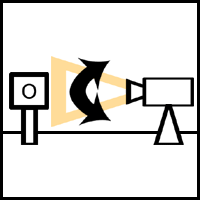Tilt (camera)


Tilting is a
The camera's tilt will change the position of the horizon, changing the amount of sky or ground that is seen.[5] A tilt downward is usually required for a high-angle shot and bird's-eye view while a tilt upward is for a low-angle shot and worm's-eye view. The vertical offset between subjects can reflect differences in power, with superiority being above.
Tilting can be used as a
A tilting Point-of-view shot expresses either attention or head motion. Attention might convey a potential love interest with "elevator eyes" or concern with sizing up an opponent.[7] Head motion could show a nodding "yes". Combining tilt with camera position could show a face planting or tipping over backwards.
Minor tilting is used for reframing to maintain headroom.[9]
Extreme tilting would follow the subject past the zenith or nadir to a full 180 degrees, starting or ending with an inverted view of the world.
The Dutch angle, also known as Dutch tilt, is a head tilt to one side, is a type of camera shot where the camera is set at an angle on its roll axis so that the shot is composed with vertical lines at an angle to the side of the frame, or so that the horizon line of the shot is not parallel with the bottom of the camera frame.
See also
- Pan tilt zoom camera(PTZ)
- Panning (camera)
- Tripod (photography)
- View camera
- Zoom lens
References
- ISBN 9781903053225.
- ISBN 9781136048340.
- ISBN 9788126903481.
- ISBN 9781317422693.
- ISBN 9780240516813.
- ^ "Camera Movement Techniques". Videomaker.com. Retrieved 2018-02-26.
- ^ ISBN 9781136057335.
- ^ "The Opening Shot of Star Wars: A New Hope Tells Way More Than You Might Think". Den of Geek. Retrieved 2018-02-26.
- ^ "Part 3: Cinematography – Film Analysis". filmanalysis.coursepress.yale.edu. Retrieved 2018-03-05.
